What to do when your Amazon Seller Account gets placed on a hold?
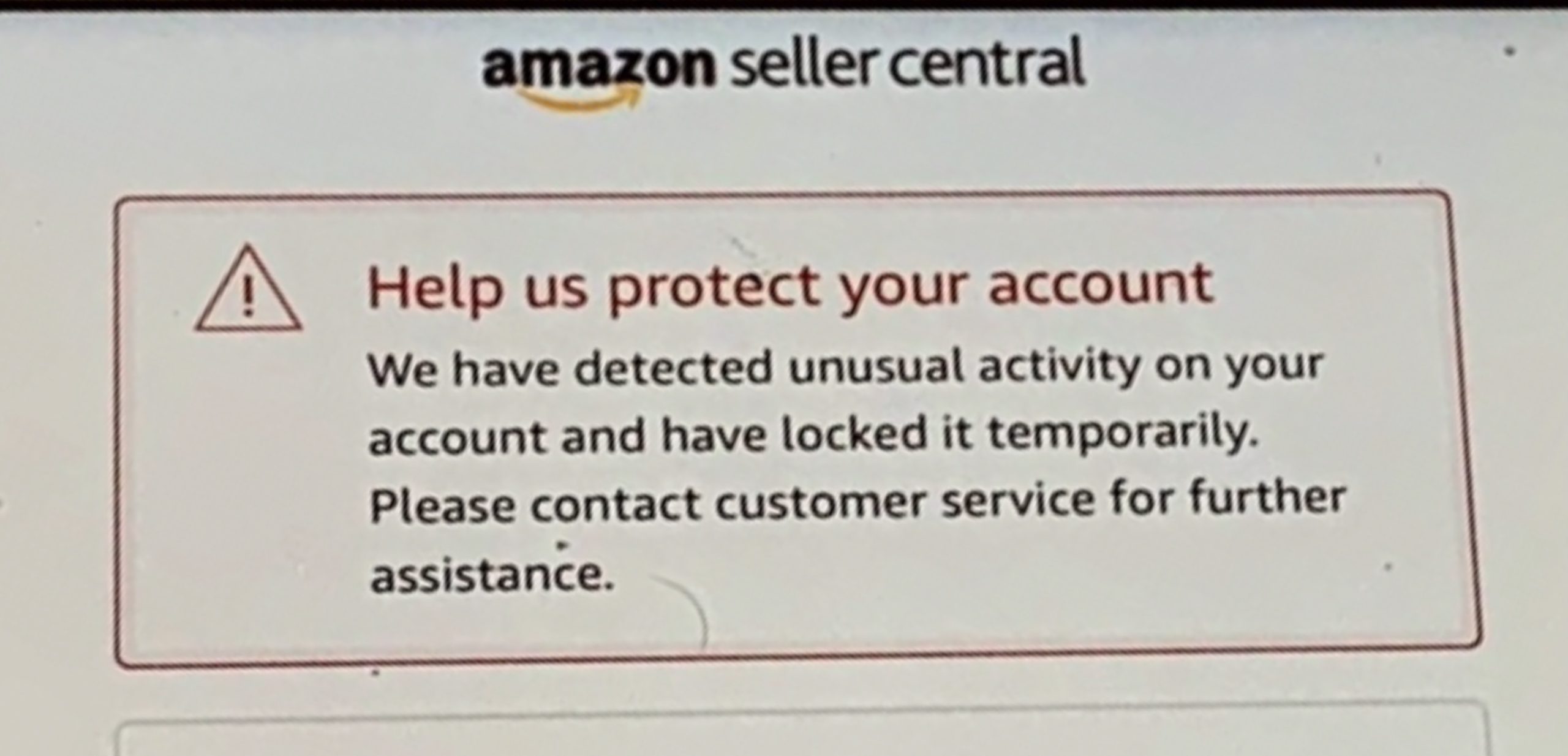
Have you suddenly lost access either to your buyer or seller account without any notification from Amazon? Are you hopeless and desperate? Read the most detailed article addressing this topic from a seasoned advisor Kika Angelic to learn everything you need to know.
When something goes wrong on the Amazon marketplace, your Seller Account will typically get suspended following a deactivation e-mail, until you address the matter by preparing a Plan of Action. While the situation can be very upsetting, at least you can still login to the Seller Central and manage your store.
However, there are severe actions which Amazon routinely takes, that cause even more distress to third party sellers than regular suspensions. These are called “Account Holds” and formally referred to as “frauded accounts” or “frauded account status” by Amazon employees.
Amazon places a hold on an account when security concerns are raised – this can happen due to numerous reasons, which are not mentioned in public policies available in the Seller Central.
In addition, no e-mails or notifications are sent to the affected individuals informing them of this action being taken or advising any steps how to proceed and have the matter resolved. This makes the experience very scary and unexpected.
Here I am listing some very common reasons for seller or buyer account holds on Amazon:
- You suddenly logged into your buyer/seller account after a long time of dormancy and then immediately started making updates to account details or listing products.
- You accessed your buyer/seller account from an unusual location (distant foreign country) or using a new device.
- You repeatedly entered incorrect password or OTP code when entering your buyer/seller account.
- Your charge method on file was rejected when making a purchase as a buyer or paying for selling fees and a chargeback was filed or the card was reported as stolen.
- You used your buyer account to damage a competitor. This includes placing test buys.
- You misused your buyer account for facilitating drop shipping, especially through Amazon Prime.
- You are misusing Amazon gift cards for illegal activity to avoid being traced.
- You have a high purchase return rate exceeding 10% as a buyer and Amazon has evidence that you are sending back damaged/unsellable items, therefore causing them expenses.
- You experienced a sudden increase in sales as a seller and it appears to Amazon that you are not fulfilling the orders. This is especially the case with old accounts, which are not subject to disbursement holds.
- You are maintaining a high amount of sales without entering a sufficient tracking information and you have long shipping and handling times.
- You are confirming orders as shipped and then refunding, when you run out of stock, instead of properly cancelling orders.
- You sold or transferred your buyer/seller account.
- You appear to be aiming to artifically increase the sales rank of your products.
- You have a lot of unanswered Buyer-seller messages and your Seller Account is experiencing an increase of non-receipt claims.
- You are listing a high volume of new listings at a “too good to be true” price.
- You are offering replacements to customers reporting non-receipt claims.
- Your Seller Account is old and not subject to payment holds and you are requesting daily disbursements while seeing an increase of sales.
- You are e-mailing Amazon’s higher departments with frivolous complaints, including complaining that you lost the Buy Box or that your items are no longer selling.
There are many other reasons and the situations mentioned above are just some examples.
When a buyer or seller account is placed on a hold by Amazon, the buyer/seller loses his entire access and ability to login.
Amazon Seller Account holds typically don’t affect both the buyer and seller account. However, if you share the same login e-mail address with your buyer account as a seller, you won’t be able to login into the Seller Central either, despite your Seller Account remains fully active and accepting orders.
If you are unsure about your type of a hold, here are some notes which may help you:
Buyer account holds – The seller is unable to access his buyer account but his storefront still displays all products as available for sale. All Amazon-related notifications continue being sent to the seller through e-mail or Amazon Seller App. If the affected seller uses identical login details, then he is unable to access the Seller Central. He can still post on the Amazon Seller Forum and ask for help.
Seller account holds – The seller is unable to access both his buyer and seller account. His storefront appears suspended and no products are available for sale. No Amazon-related e-mails or notifications are being received. The affected seller is unable to post on the Amazon Seller Forum and if he posts there using a different Seller Account requesting help with restoring his access to the other store, one of the moderators will immediately permanently ban him from the forum and delete any thread started regarding the matter.
Amazon Buyer Account Holds
Buyer account holds are more common and they are quite easy to get resolved. Some of them are lifted within a few minutes or hours past enforcement, but it remains crucial to act quickly.
The affected individual can call the buyer Customer Service and explain the matter. Following this, he should be connected to an Account Specialist over the phone or advised to e-mail address-verification@amazon.co.uk. It may be necessary to provide Amazon some verification documents such as bank account statements or credit card statements.
Why is Amazon placing Buyer Accounts on a hold?
When detecting suspicious activity, including having a payment for an order rejected by the bank, incorrect password being entered or the account accessed from an unusual location (such as Egypt, Algeria by a Belgian or Japanese registered buyer), Amazon suspects that the charge method was stolen or account compromised. They will therefore place the account on a hold and request verification documents.
If a newly registered buyer uses $1000 worth of Amazon gift cards on their first day to buy the latest iPhone, this raises red flags as well. Scammers are routinely buying Amazon gift cards using stolen credit cards and then purchasing expensive goods. The illegal activity doesn’t end there. If they manage to receive the goods, they will often request a return and send back a box filled with dirt or a brick to receive a full refund.
There are buyers who are misusing Amazon’s generous return policies to send back faulty items from home and exchange them for a new unit or even returning half-empty boxes with accessories and content missing, claiming that it was received in this condition. While Amazon rarely refuses a return or a refund, they are silently monitoring the numbers and once the loss exceeds any profit, action will be taken against the customer.
Many sellers will place an order from a competitor to damage them or try to take advantage of their own knowledge of Amazon’s inner performance targets and extort their supplier by threatening them with a negative feedback.
Amazon can detect potential fraudulent activity and following this, they will take action.
How to prevent and proactively protect your business against Buyer Account Holds:
- Never purchase anything using the buyer account connected to your Amazon storefront and maintain a separate buyer account to buy on Amazon or don’t buy on Amazon at all. If you decide to buy through Amazon anyway (just like I do), don’t leave any Seller Feedback Ratings or Product Reviews and don’t initiate returns, cancellations, A-to-Z Guarantee Claims or Chargebacks. Don’t click on “Helpful” or “Unhelpful” votes on Product Reviews.
- Enable user permissions through the Amazon Seller Central for at least one alternative e-mail address. This way, once your Buyer Account gets placed on a hold, you will be still able to access your Seller Account using the backup e-mail address, which has User Permissions.
Amazon Seller Account Holds
Seller Account holds are less common than Buyer Account holds, however once they happen, their effects are extremely damaging to the entire business affected and it can take anything from a few weeks to years to have them lifted.
Merchants registered before August 2016 are more likely to have their accounts placed on a hold, because their funds are not subjected to rolling reserves and they are able to request a full disbursement anytime, prior to fulfillment.
You will most likely learn about your Seller Account being placed on a hold by seeing an innocently looking message in a red rectangle stating “Help us protect your account: We have detected unusual activity on your account and have locked it temporarily. Please contact customer service for further assistance”, when trying to login:
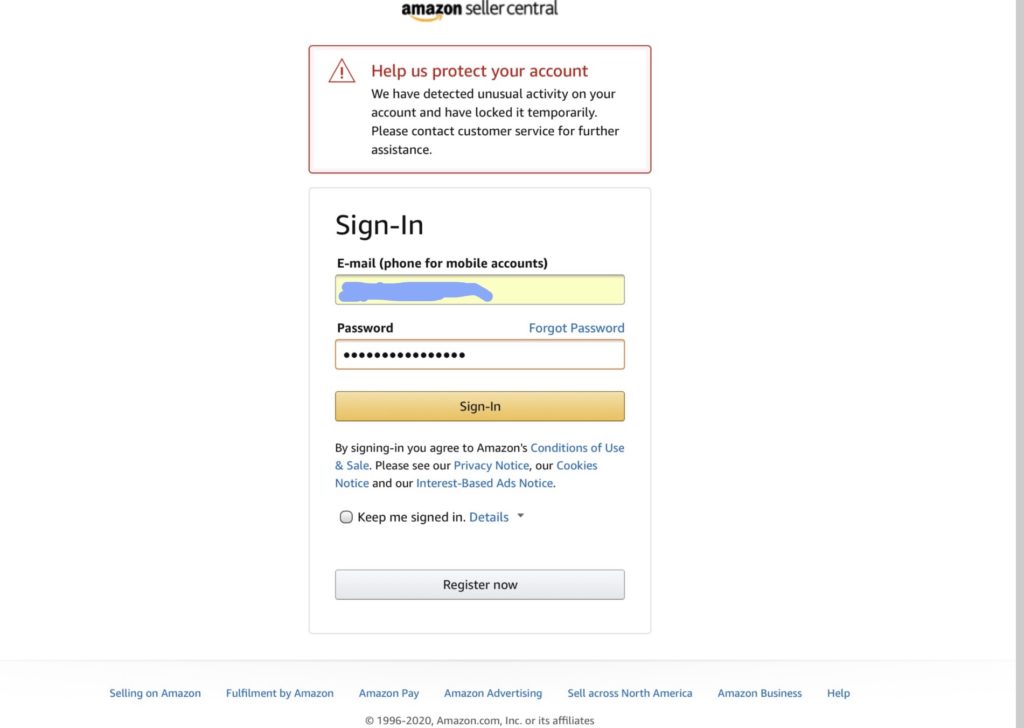
Alternatively, you will see a wording stating that you are not authorized to access the Seller Central or that specific user:
“Status – Status for your currently selected merchant and marketplace – (i) Welcome to Seller Central – You don’t have access yet. Sign in as a different user.”
There will be strange looking CID, MCID, MKID and S codes under the notice, along with a date and time, as pictured:
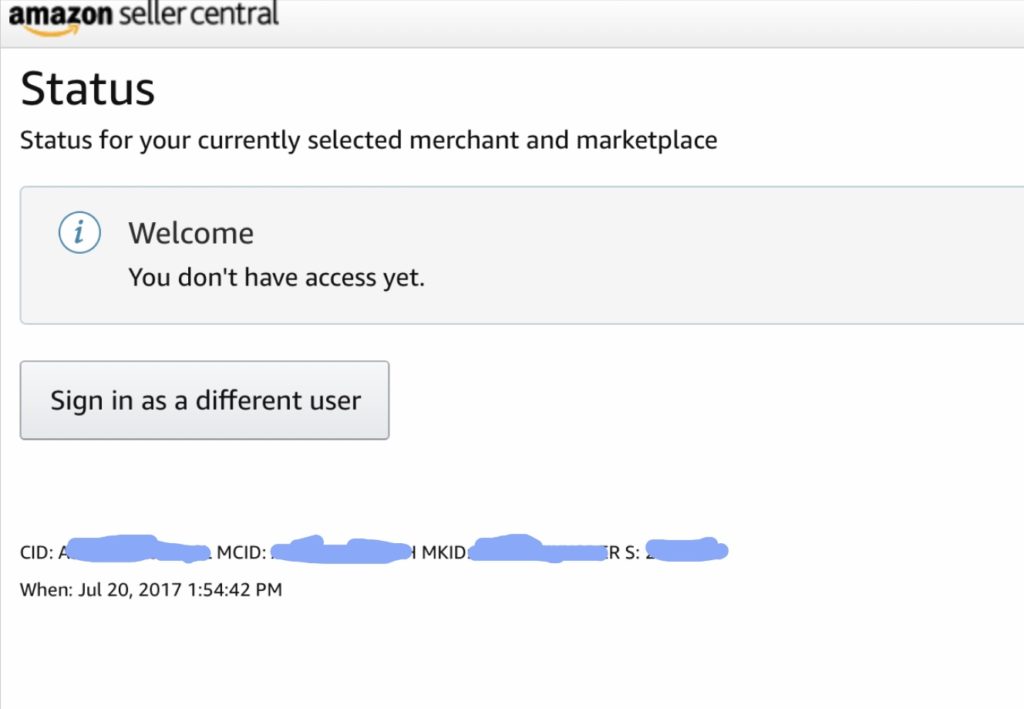
Amazon keeps changing the login screens when a “frauded” seller tries to enter the Seller Central, however you will most likely see something similar, as above.
If you think that you will be able to simply appeal and get reinstated, this is not the case here. Since you are not sent any explanation, you have no access to your account, you can’t post on the forum or contact Amazon in any other way, you will very soon become very desperate.
After spending several days escalating the matter and e-mailing all possible Amazon departments including the Seller Performance, Managing Director or Jeff Bezos, here is what will typically land into your e-mail inbox:
| From: seller-performance@amazon.co.uk Dear Seller, We have discovered information that indicates your Amazon seller account has engaged in deceptive, fraudulent, or illegal activity. This conduct violates the Amazon Services Business Solutions Agreement. As a result, we have closed your Amazon seller account to prevent harm to our customers, other selling partners, and our store. Your listings have been deactivated, and any open orders have been cancelled. If you believe there has been an error, please respond to this email. Sincerely, Amazon |
As you can see, the wording doesn’t mention any specific reason or an indication of a reason. It will be up to you to find out what is behind the account hold.
Sadly, this specific type of enforcement is typically enacted towards large, well-established sellers, who are processing thousands of orders per month, therefore they end up being presented with a hopeless situation – knowing that their metrics will explode if they don’t regain access quickly.
Many victims will immediately search for a prominent Amazon Seller Account reinstatement expert, thinking that a payment of a large retainer fee ranging from $1000 to $20000 will get them back to the platform. However, you should know that the vast majority of such service providers will reject this type of work or only promise assistance with no guarantee of a success. You will be told that “frauded accounts” are nearly impossible to appeal.
I have been reinstating Amazon Sellers subjected to Seller Account Holds since I was 19 and I possess a deep understanding of Amazon’s standard operating procedures. Rather than requesting a fortune from desperate businesses, I was mostly assisting them completely for free, just to perfect my skills and learn something new.
However, because of my success, I became targeted both by unsuccessful rival advisors and their befriended Amazon Executives, who got me defamed and removed from the Amazon Seller Forum, where I was providing the free assistance. If you don’t know my story, here you can learn more and even support me, if you found this article helpful: https://www.gofundme.com/f/help-for-victim-of-cyberbullying-on-Amazon-site.
I am currently still offering assistance with Amazon-related matters, however because of my situation and increased expenses, I started charging a small fee of $24.99 through my OnlyFans page, where anyone can subscribe to access my Amazon appeal work at www.onlyfans.com/kikaangelic. There, you will be able to find example appeals addressing Seller Account Holds or even message me privately and have me assist you.
The vast majority of Seller Account Holds which I witnessed in my client’s cases were enforced towards foreign sellers, often drop shippers, who processed thousands of orders, frequently refunded, didn’t ship using tracked shipping carriers supported by Amazon and setup long shipping and handling times.
Others were small sellers who got into a conflict with a competing merchant over a listing, which they shared and unwisely placed a test buy to leave them a negative feedback.
But each case is individual. The most important thing is not to run out of your appeal attempts by emotively bombarding Amazon with e-mails – you only have a few attempts available.
Account Holds are not appealed with a Plan of Action, but by proving Amazon that they “erred” – were wrong when making the decision.
I have seen cases where sellers did not appeal at all but instead aimed to “go public” and “go viral” and achieved a restoration of their account by publishing a catchy blog or a shocking LinkedIn post, evidencing their outrage and frustration.
Why is Amazon placing Seller Accounts on a hold?
Amazon has a so-called “Good Seller Gone Bad” policy, which describes a common scenario, where someone sells their aged dormant Seller Account to a different entity. That entity then lists a large amount of expensive and popular products at a fraction of their recommended retail price and sets up very long handling and shipping times to ensure a 1-2 months Estimated Delivery timeframe.
The aim is to generate as many customer orders as possible and disburse all earnings daily, without fulfilling anything. As you know, aged Seller Accounts are not subject to any rolling reserves, therefore they can request a full payment every day. This is the reason, why are you seeing so many suspicious individuals inquiring across Facebook groups, whether someone would be willing to sell their “aged” account. The sellers will implement various stalling tactics, including offering replacements or refunding just the customers who complain, while still keeping a large portion of the earnings from those who did not notice that their purchase never arrived.
Sadly, many innocent sellers, including dropshippers, international sellers from smaller distant countries without reliable carrier networks or nomadic freelancers are wronged by Amazon’s automated bots scanning through the Seller Central interface hoping to catch bad actors.
Thousands of such sellers lost their accounts during the coronavirus pandemic, seeing a surge in sales, while delivery of shipments was being delayed due to various restrictions imposed in the buyer’s destination country.
What is happening inside your Seller Account, while it is placed on a hold?
If it is just your Buyer Account, which is placed on a hold, then you will be able to view your active storefront, receive e-mails with notifications regarding Buyer-seller messages, return requests, FBA notifications, order notifications and similar… the only difference will be that you won’t be able to login. And keep in mind that Amazon will still issue you defects for any A-to-Z guarantee claims or negative feedbacks complaining about unresponsiveness.
If it is your Seller Account which is placed on a hold, then you will stop receiving any notifications from Amazon, effective immediately. Any pending orders will be cancelled. Amazon will start reversing all of your historical credit card chargebacks which were covered by them or decided in your favor and charging them out of your Seller Account balance. All of your recent customers will be e-mailed and informed that you abandoned the platform and invited to ask for refunds. A special team of Amazon Account Specialists will begin “cleansing” your account, which may include removing listings which you created.
To learn what will happen following account reinstatement, wait till the end of my article.
How to prevent and proactively protect your business against Seller Account Holds:
- Never confirm shipment and then refund as an alternative to order cancellation. Amazon is secretly monitoring your refund rate and they are also scanning Buyer-seller messages for evidence of sellers initiating contacts and apologizing for running out of stock and offering a refund. Cancelling may damage your metrics but not as much as trying to game the system.
- If you are based in one of Amazon’s partnered countries, purchase shipping from Amazon or use FBA. Even if you are shipping untracked or using a carrier not supported by Amazon and you have a very long handling and shipping time, offer an Expedited delivery and Next Day or Second Day service and deliver those orders using FedEx or a different carrier integrated with Amazon. Amazon investigators looking for a proof of fulfillment will accept this as evidence that you are able to fulfill orders quickly if needed and it will prevent a hold being placed against your account.
- When drop shipping, try to have at least one unit of every product which you sell available in stock, so you can fulfill the order yourself, in case your supplier runs out of stock.
- If you are a FBM seller, answer Buyer-seller messages on time and login to the Seller Central at least once a day. Otherwise, having many messages piled up and no activity on your part may attract Amazon’s investigators, thinking that you have abandoned the business.
- Never offer buyers any incentives for removing a feedback, editing a product review or withdrawing an A-to-Z Guarantee claim. Having your Seller Account placed on a hold is not worth it.
- Never place any “test buys” or attempt to participate in wars with competing merchants. If someone is genuinely infringing your intellectual property, take a legal action or sign up for the Amazon Brand Registry, alternatively have your brand gated.
- Never hire any virtual assistants to manage your entire Amazon Seller business. I can confirm that 90% of those who appointed me to assist them with having their account holds lifted were either successful British, American or Israeli businessmen, who wanted to earn without putting much time and effort into managing their business. They had a lot of inventory and resources, however instead of investing into appropriately trained local staff, aware of Amazon’s policies and performance targets, they appointed cheap Fiverr-grade virtual assistants from Asia, who destroyed their accounts. The account’s metrics looked perfect, however if the business owners looked closer, they would be able to see that their virtual assistants were heavily incentivizing any unhappy customers by refunding and sending additional credits. After having their account access restored, my clients had to promise me that they will never use any virtual assistants again.
- When experiencing a sudden increase of non-receipt complaints (which includes Buyer-seller messages, not just A-to-Z Guarantee claims), place your Seller Account on Vacation Settings until the whole situation improves. Many such sellers are instead trying to increase their sales and improve their metrics, which actually worsens the matter in Amazon’s eyes and attracts the attention of Account Specialists, thinking that you are a “Good Seller Gone Bad”, who is trying to generate a lot of sales and then run away with money.
- Don’t file a credit card chargeback when Amazon charges you through your Seller Account, even if you disagree with the amount.
- Only contact Amazon or submit appeals when you really have to. Agressively appealing every defect/enforcement and demanding to have it removed may attract unwanted attention to your business from senior Amazon employees, who may not appreciate your proactiveness and find it suspicious.
Warning signs of an account hold incoming
I should also mention, that you can see warning signs in your Seller Account indicating that a Seller Account Hold may be incoming.
Velocity reviews are one of them.
If you ever receive a Velocity Review and your funds are withheld, DON’T try to aggressively appeal and have it lifted (like most sellers do) unless your Seller Account is deactivated during the review.
In such case, appeal the enforcement by providing Amazon with all of the following:
| – How long you’ve been in business – The sources of your inventory – Anticipated monthly sales on Amazon – The availability of items for shipping – The address of any retail locations – Links to other Amazon websites where you are actively selling – Tracking information for recently dispatched orders – Your tax number |
Additionally, don’t place your Seller Account on Vacation Settings. Wait for Amazon to carefully review your account and ensure that orders are still getting fulfilled, despite you aren’t getting paid (yes, I know how badly it sounds).
This is typically the last pre-account hold measure, where Amazon is still giving you a chance to recover. Velocity Reviews can take anything from a few days to up to 90 days to be completed, however once this is done, your funds will be automatically released and you may continue trading undisrupted.
I would advise you to always keep a financial reserve, which you can use in case you experience a Velocity Review.
What will happen following account reinstatement from an account hold?
If it was just your Buyer Account, which was placed on a hold, while your Seller Account remained active – just inaccessible, then you will have a bad time dealing with all the resulting defects and complaints from customers. Amazon will not help you remedy the situation in any way.
Since reinstatements following a Seller Account Hold are extremely rare, Amazon prepared very interesting remedies for affected sellers. Once you return back to the Seller Central, the account will be in a pristine condition, regardless of any metrics exceeding the targets.
All existing suspended accounts, which are a part of the account placed on a hold will be fully reinstated and operational, including accounts which were suspended many years ago for unrelated issues.
Any A-to-Z guarantee claims for orders placed just before the hold will be funded by Amazon and historical issues will no longer be considered against the seller.
What to do if you know someone who can no longer access his Amazon Seller Account
Every day, I can see desperate sellers begging for help on social media with what are clearly Seller Account Holds, but no one can provide them proper assistance.
If you ever encounter someone like this, please show them this article or advise them to reach out to me at www.onlyfans.com/kikaangelic, where they can get a genuine resolution to their problem.
Additionally, here you can watch my YouTube video, where I am presenting you several secret tips about appealing Amazon Seller Account suspensions (don’t be confused by the opening of the video, where I am enjoying a vacation – it’s a part of the story):

If you are one of the millions of third party sellers doing business across Amazon’s platforms, you are already used to having to adapt to the announcements of extremely strict, unexpected policies which lack clarifications of the most crucial points.
This evening, Amazon suddenly e-mailed their third party sellers on the United States platform to inform them about a newly-announced policy called “On-time delivery rate” or OTDR. Here you can review the full policy.
Many sellers reacted with confusion, anger and outrage and expressed their views on social media. In this article, I would like to respond with clarification to the most common concerns.
Below you can review the e-mail from Amazon regarding On-time delivery policy:
| New updates to our On-time delivery policy and changes to shipping settings Dear seller, Fast and accurate delivery is essential for customers and often determines where they choose to shop. Over time, we’ve learned that the best way to ensure reliable on-time delivery for customers is to set accurate Handling and Transit Times and to choose reliable shipping services. To help reduce late deliveries and improve delivery speeds, we’re updating our On-time delivery rate (OTDR) policy. Effective 09/23/2024 [60 days from today], you’ll need to maintain a minimum 90% On-time delivery rate (OTDR) without promise extensions to have seller-fulfilled products listed on Amazon.com. We will start by addressing sellers with the lowest OTDR performance. This policy does not apply to offers using the Fulfilled by Amazon (FBA) service because sellers are not responsible for on-time delivery promises for FBA orders. Your current OTDR, calculated between 7/5/2024 and 7/18/2024 is 100.0%. Your account is currently in healthy OTDR standing. You can manage your delivery dates using the tools we’ve provided, or you can manually adjust your Transit Time and Handling Time settings. We designed these tools to set accurate delivery dates, reduce late deliveries, and to meet or exceed the minimum OTDR requirement, and because Amazon is making calculations on your behalf that affect OTDR, you will get OTDR protection from late deliveries on items shipped through Standard Shipping if you use all three tools as follows: a) Shipping Settings Automation (SSA), for Professional sellers, sets accurate delivery dates through automated Transit Time calculations of your preferred shipping services. You must choose one of the preferred ship methods in the SSA templates, which will mark the Transit Time on the shipping template as “Managed by Amazon”. b) Automated Handling Time (AHT), for Professional sellers, sets accurate Handling Times per SKU based on how long it usually takes you to pass each SKU to carriers. You must ensure that AHT is enabled in your shipping settings. c) Amazon Buy Shipping, for both Professional and Individual selling plans, sells shipping labels that use highly-reliable ship methods. You can use Amazon Buy Shipping through Manage Orders, Shipping API, Veeqo, or select multi-channel integrators with access to Amazon Buy Shipping. You must choose shipping labels marked as “OTDR Protected” when using Amazon Buy Shipping or Veeqo. We’ll also make changes to shipping settings to help Professional sellers set more accurate delivery dates: a) Transit Time settings: On 08/24/24 [30 days from today], our Transit Time requirements will be updated to match the delivery capabilities of shipping services. If you are shipping within the contiguous United States (excluding Hawaii, Alaska, and US territories), you can set a maximum Transit Time of 5 days for Standard shipping and 8 days for Free Economy shipping. To learn more, go to Default Transit Time. b) Handling Time settings: On 09/23/24 [60 days from today], to help improve the accuracy of Handling Time, we’ll enable Automated Handling Time (AHT) for sellers that have a manually configured Handling Time that is 2 or more days slower than their actual Handling Time (also known as a Handling Time gap). To see your Handling Time gap, review your Fulfillment Insight dashboard. You can review your OTDR on your Account Health dashboard. We also recommend you review the “Deliver by” dates for your orders to ensure they match the expected delivery date without promise extensions. To learn more, go to On-time delivery. Thank you, Fulfilled By Merchant Team |
This is the post published by Amazon regarding the matter elsewhere:
| New updates to our on-time delivery policy and shipping settings Fast and accurate delivery is essential for customers and often determines where they choose to shop. Over time, we’ve learned that the best way to ensure reliable on-time delivery for customers is to set accurate handling and transit times and to choose reliable shipping services. To help reduce late deliveries and improve delivery speeds, we’re changing our on-time delivery rate (OTDR) policy. Effective September 25, 2024, you’ll need to maintain a minimum 90% OTDR without promise extensions to have seller-fulfilled products listed on Amazon.com. We will start by addressing sellers with the lowest OTDR performance. For a great customer experience, we recommend that you maintain a 95% or greater OTDR for all seller-fulfilled orders. This policy does not apply to offers using the Fulfillment by Amazon (FBA) service because sellers are not responsible for on-time delivery promises for FBA orders. Also, we’ll make the following changes to shipping settings to help sellers with Professional selling plans set accurate delivery dates: Transit time settings: On August 25, 2024, our transit time requirements will be updated to match the delivery capabilities of shipping services. If you’re shipping within the contiguous United States (excluding Hawaii, Alaska, and US territories), you can set a maximum transit time of five days for standard shipping and eight days for free economy shipping. To learn more, go to Default transit time. Handling time settings: On September 25, 2024, to help improve the accuracy of handling time, we’ll enable automated handling time for sellers that have a manually configured handling time that is two or more days slower than their actual handling time (also known as a handling time gap). To see your handling time gap, review your Fulfillment Insight dashboard. We understand changes like this are significant and require time to prepare. You can manage your delivery dates using the tools we’ve provided, or you can manually adjust your transit time and handling time settings. We designed these tools to set accurate delivery dates, reduce late deliveries, and to meet or exceed the minimum OTDR requirement, and because Amazon is making calculations on your behalf that affect OTDR, you will get OTDR protection from late deliveries on items shipped through standard shipping if you use all three tools as follows: Shipping Settings Automation (SSA), for Professional selling plans, sets accurate delivery dates through automated transit time calculations of your preferred shipping services. You must choose one of the preferred ship methods in the SSA templates, which will mark the transit time on the shipping template as “Managed by Amazon.” Automated handling time, for Professional selling plans, sets accurate handling times per SKU based on how long it usually takes you to pass each SKU to carriers. You must ensure that automated handling time is enabled in your shipping settings. Amazon Buy Shipping, for both Professional and Individual selling plans, sells shipping labels that use highly-reliable ship methods. You can use Amazon Buy Shipping through Manage Orders, Shipping API, Veeqo, or select multi-channel integrators with access to Amazon Buy Shipping. You must choose shipping labels marked as “OTDR Protected” when using Amazon Buy Shipping or Veeqo. You’ll receive an email with your current OTDR and recommendations on how to improve if you’re below the minimum requirement. To learn more, review your OTDR on your Account Health dashboard or go to On-time delivery. |
While this policy brings nothing new to most FBM Amazon sellers who are based in the United States or major countries with Amazon marketplace presence, it may sound confusing and bring uncertainty to Amazon sellers outside of the Valid Tracking Rate criteria, who don’t have access to Buy Shipping Services. I would like to address the most common questions.
What does OTDR mean for international sellers?
For sellers based in smaller countries all over the world, including Europe, access to easily available international online trackable shipping is an unachievable luxury.
In smaller countries, there is no infrastructure to facilitate international shipping with online tracking. As the OTDR policy states, using the Buy Shipping Services is the recommended way of complying with the OTDR policy. However, Buy Shipping Services are not available in countries with lack of international online tracking services offered and provided by carriers.
Because of this, sellers with no access to Buy Shipping Services have always been exempt from the Valid Tracking Requirement and also any other tracking-related metrics and policies.
OTDR applies to all sellers equally. According to the policy, effective September 25, 2024, you must maintain a minimum 90% on-time delivery rate (OTDR) without promise extensions to have seller-fulfilled products listed on Amazon.com. An OTDR below 90% can result in restriction of your ability to have seller-fulfilled products listed.
If your OTDR is below 90%, you can appeal by clicking on “Submit appeal” at the top of your Account Health dashboard. Sellers on Individual selling plans or sellers on a Professional selling plan but shipping from outside the US must submit an appeal request indicating how they will improve their OTDR.
However, the OTDR measures the percentage of your tracked seller-fulfilled items that were delivered on or before the seller-promised “Deliver by” date. OTDR is the average of all of your tracked shipped items, not just a specific SKU or shipment.
This means that if you are not subject to Valid Tracking Rate requirement, then only the performance of your tracked FBM orders will be measured for OTDR percentage calculation.
Please note that the OTDR policy doesn’t mean that you will now have to ship every FBM order tracked.
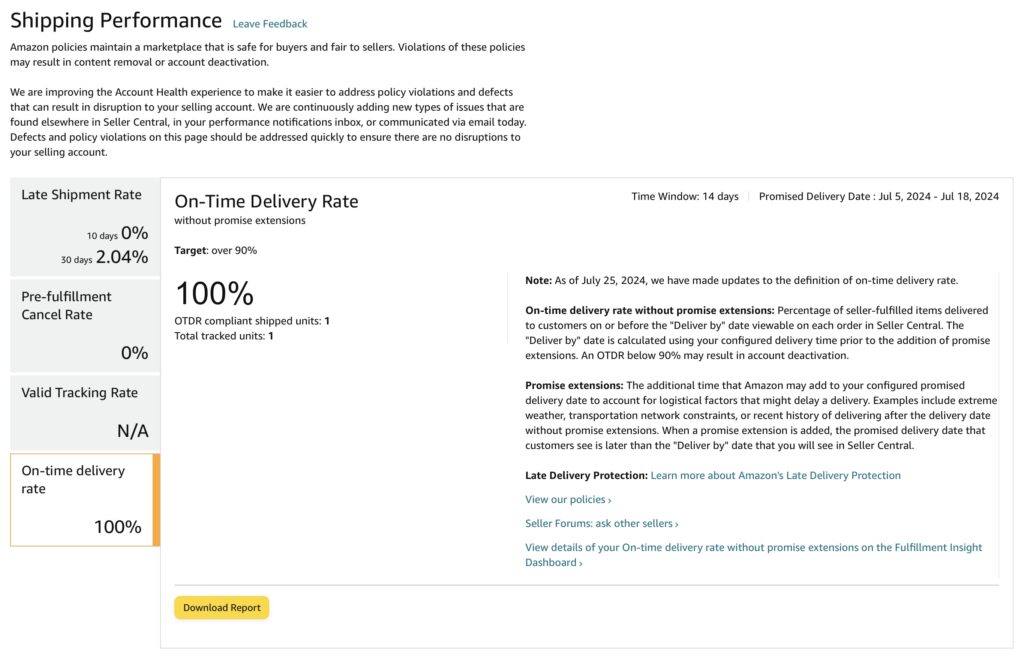
Does Amazon offer any tools for international sellers that can help them improve their OTDR and meet the Amazon’s OTDR requirements?
No. OTDR Protection is only applicable to Professional sellers shipping from the US, as all of the required tools are currently not available on Individual selling plans or to Professional sellers that are shipping from outside of the US.
This indicates that if you are an international Amazon Seller who decides to ship orders tracked, you will need to carefully select a carrier who can deliver within each order’s promised Estimated Delivery Date, otherwise you may have your FBM shipping ability revoked.
What are “Promise Extensions”?
Promise Extensions are the additional time that Amazon may add to your configured promised delivery date to account for logistical factors that might delay a delivery. Examples include extreme weather, transportation network constraints, or recent history of delivering after the delivery date without promise extensions. When a promise extension is added, the promised delivery date that customers see is later than the “Deliver by” date that you will see in Seller Central.
When your order is subject to a Promise Extension, the customer may be unable to open an A-Z claim and will be advised to wait until the order gets delivered.
Where can I access my current OTDR performance?
The OTDR metric is currently only available on the United States platform. You can view your performance by accessing the Account Health Dashboard, where the metric is on the right side, under Shipping Performance as “On-Time Delivery Rate without promise extensions”.
Where to get more help and information regarding OTDR
If you have any other questions related to the OTDR and need fast and professional assistance provided for free and without wait, join our discussion forum for Amazon Sellers.
To stay in touch on Facebook, feel free to join and post into my large Amazon Seller Performance – Friendly Advice – Worldwide Facebook group, where you will be very welcome too.
Here, you can also review the full OTDR policy reposted from Amazon help page, which mainly focuses on answering the questions from US based sellers:
| Frequently asked questions about on-time delivery rate (OTDR) What is Amazon’s policy for on-time delivery without promise extensions? Effective September 25, 2024, you must maintain a minimum 90% on-time delivery rate (OTDR) without promise extensions to have seller-fulfilled products listed on Amazon.com. An OTDR below 90% can result in restriction of your ability to have seller-fulfilled products listed. For a great customer experience, we recommend that you maintain a 95% or greater OTDR for all seller-fulfilled orders. What is changing? Our updated policy requires a minimum 90% OTDR without promise extensions to have seller-fulfilled products listed on Amazon.com. An OTDR below 90% can result in restriction of your ability to have seller-fulfilled products listed. To help provide a positive customer experience, we recommend that you maintain a 95% or greater OTDR for all seller-fulfilled orders. We are also changing the way we measure OTDR to now measure the percentage of your tracked seller-fulfilled items that were delivered on or before the seller-promised “Deliver by” date prior to promise extensions being added. Before this change, OTDR was measured after promise extensions were added. Promise extensions are additional days that we may add to the delivery date to account for logistical factors that may delay a delivery such as extreme weather, transportation network constraints, or recent history of a seller delivering shipments after their set delivery date. This policy does not apply to offers using the Fulfillment by Amazon (FBA) service because sellers are not responsible for on-time delivery promises for FBA orders. Note: We will communicate as we roll out the OTDR policy, and any changes from the policy as it stands today, that may affect you. What will happen to my account if my OTDR falls below the 90% minimum requirement? An OTDR below 90% can result in restriction of your ability to have seller-fulfilled products listed. If that happens, we’ll notify you of the policy violation and you can appeal by clicking the Submit appeal button at the top of your Account Health dashboard to request reinstatement of your capabilities to list seller-fulfilled products. The request will be reviewed within 72 hours and should include the following information: The issues that led to a low on-time delivery rate The actions that you’ll take to improve your on-time delivery rate The steps that you’ve taken to prevent future issues regarding on-time delivery On subsequent policy violations, if your OTDR is still below 90%, you can appeal by clicking Submit appeal at the top of your Account Health dashboard. To get reinstated: Sellers on Individual selling plans or sellers on a Professional selling plan but shipping from outside the US must submit an appeal request indicating how they will improve their OTDR. Professional sellers that ship domestically within the US will be required to meet the 90% OTDR requirement by using the following Amazon free-to-use fulfillment and shipping tools for their seller-fulfilled orders for the next 180 days: Shipping Settings Automation (SSA) to set accurate delivery dates through automated transit time calculations of your preferred ship methods. Automated handling time to set accurate handling times per SKU, based on how long it usually takes you to pass each SKU to carriers. For new SKUs, the default handling time will apply until there are enough shipments for your automated handling time to be calculated. Amazon Buy Shipping to buy shipping labels that use highly reliable shipping methods for both Professional and Individual selling plans. You can use Amazon Buy Shipping through Manage Orders, Shipping API, Veeqo, or select multi-channel integrators with access to Amazon Buy Shipping. How is OTDR calculated? OTDR measures the percentage of your tracked seller-fulfilled items that were delivered on or before the seller-promised “Deliver by” date. OTDR is the average of all of your tracked shipped items, not just a specific SKU or shipment. To calculate OTDR without promise extensions, we’ll consider a 14-day window of time. We’ll pull data from shipments that had a promised delivery date in the last 21 days, and exclude the most recent 7 days as the shipments from last 7 days may still be in the process of being delivered. For example, if you had 130 orders with a promised delivery date in the last 21 days, and 30 of those has a promised delivery date in the last 7 days, OTDR will be calculated excluding the 30 orders from the last 7 days (130 – 30 =100). Of those 100 orders delivered, if 90 were delivered on or before the promised “Deliver by” date, your OTDR would be 90%. Seller’s promised “Deliver by” date is calculated using seller-set handling and transit time, prior to the addition of promise extensions. This date may be different than the delivery date shown to customers if promise extensions were added. For example, for a seller with a set handling time of 1 day and set transit time of 2 days: The promised “Deliver by” date will be in 3 business days. So, if an order is received on a Monday, this order would need to be delivered by Thursday (seller-promised “Deliver by” date) to be considered delivered on time. However, if 1 day of promise extensions was added to that offer, the promised delivery date the customer saw while purchasing would have been Friday. Irrespective of the date shown to the customer (Friday), sellers must deliver by their set “Deliver by” date (Thursday) for the shipment to be considered delivered on-time. Shipped units will be considered as OTDR compliant if either the delivery occurred on or before the “Deliver by” date shown on Seller Central, or the following 3 conditions were met: The shipped SKU was assigned to a shipping template with Shipping Settings Automation (SSA) enabled. Your account has automated handling time enabled. You bought an “OTDR Protected” shipping label on Amazon Buy Shipping. Note: OTDR Protection is only applicable to Professional sellers shipping from the US, as all of the required tools are currently not available on Individual selling plans or to Professional sellers that are shipping from outside of the US. Does Amazon offer tools that can help me improve my OTDR and meet the Amazon’s OTDR requirements? Yes. You can manage your delivery dates using the tools we’ve provided, or you can manually adjust your Transit time and Handling time settings. We designed these tools to set accurate delivery dates, reduce late deliveries, and to meet or exceed the minimum OTDR requirement. And because Amazon is making calculations on your behalf that affect OTDR, you’ll get OTDR protection from late deliveries on items shipped through standard shipping if you use all three tools as follows: Shipping Settings Automation (SSA), for Professional selling plans, sets accurate delivery dates through automated transit time calculations of your preferred shipping services. You must choose one of the preferred ship methods in the SSA templates, which will mark the transit time on the shipping template as “Managed by Amazon”. Automated handling time, for Professional selling plans, sets accurate handling times per SKU based on how long it usually takes you to pass each SKU to carriers. You must ensure that automated handling time is enabled in your shipping settings. Amazon Buy Shipping, for both Professional and Individual selling plans, sells shipping labels that use highly-reliable ship methods. You can use Amazon Buy Shipping through Manage Orders, Shipping API, Veeqo, or select multi-channel integrators with access to Amazon Buy Shipping. You must choose shipping labels marked as “OTDR Protected” when using Amazon Buy Shipping or Veeqo. Note: OTDR Protection is only available for items shipped through Standard Shipping, items shipped through other shipping options such as Free Economy, Standard Prime, or Premium Shipping, are not eligible for OTDR protection. For example, if a seller shipped 100 orders and 15 were delivered late: Scenario A: If a seller did not use all three of Amazon’s free fulfillment and shipping tools for any of those 15 late deliveries, all 15 of their late deliveries will negatively impact their OTDR. As a result, their OTDR will be (100-15/100) = 85%. Scenario B: If a seller used all three of Amazon’s free fulfillment and shipping tools for 5 of those 15 late deliveries, only the 10 late shipments that were not using Amazon’s tools will negatively impact OTDR. As a result, the seller’s OTDR will be (100-10/100) = 90%. Note: OTDR Protection is only applicable to Professional sellers shipping from the US, as all of the required tools are currently not available on Individual selling plans or to Professional sellers that are shipping from outside of the US. Can I be exempted from the OTDR requirement if delivery delays are caused by weather or carrier network issues beyond my control? Sellers must meet the 90% OTDR requirement without promise extensions. However, if there is a major disruption event that impacts all sellers shipping to a specific region, Amazon will not count deliveries that are late as a result in your OTDR. Whether a disruption is considered to be major is a discretionary decision made by Amazon. What changes are you making to handling time and transit time settings? Transit time changes: As of August 25, 2024, transit time requirements will be updated to further align with the delivery capabilities of shipping services. If you’re shipping within the contiguous United States (excluding Hawaii, Alaska, and US territories), you can set a maximum transit time of 5 days for standard shipping (previously 8 days) and 8 days for free economy shipping (previously 10 days). To learn more, go to Default transit time. If you’re shipping internationally to the US, there are currently no changes to the transit times that you can configure. Handling time automation: As of September 25, 2024, to improve handling time accuracy, automated handling time will be enabled for sellers who have a handling time gap of 2 days or more between their set handling time and their actual handling time. To help you keep in good standing with other account health metrics related to handling time, if you have automated handling time enabled, your seller-fulfilled listings will not be deactivated if your late shipment rate (LSR) does not meet the LSR policy requirement. To see your handling time gap, review your Fulfillment Insight dashboard. How can I view my on-time delivery (OTD) metric and report? To view your OTD metrics and report on Seller Central: On the Performance menu, select Account Health. Locate the Shipping Performance section and select On-time delivery rate. You can see your OTDR metric on the Shipping Performance page. Only orders included in the current OTD defect report count against the OTDR metric. If the report contains no orders, it means either all of the orders were delivered on time or they fulfilled using Amazon’s free fulfillment tools. To download the OTD defect report, click View details and then Download report. Important: Allow 72 hours for the report and metrics to reflect any updates or edits. How can I maintain a healthy OTDR? To keep a healthy OTDR without promise extensions we recommend that you do the following: Review your OTDR without promise extensions metric on your Account Health dashboard. You can also download a report of which orders were delivered after the delivery date without promise extensions. Review the “Deliver by” date for every order. This date corresponds to the expected delivery date without promise extensions. Note that the actual delivery date that customers see may be longer because of promise extensions. If you are a Professional seller, use automated handling time to set accurate handling time per SKU based on how long it has taken you historically to hand off each SKU to carriers. Additionally, with automated handling time enabled, your seller-fulfilled listings will not be deactivated if your late shipment rate (LSR) does not meet the LSR policy requirement. If you are a Professional seller, enable Shipping Settings Automation (SSA), which sets accurate delivery dates for your orders by automatically calculating transit times of your preferred ship methods from your warehouse to each customer’s location. Select a ship method with a high reliability to deliver your order on time. You can also use Amazon Buy Shippingto buy shipping labels that have been identified to have a high reliability for On-time delivery based on Amazon’s data from millions of shipments. These ship methods have a shield icon next to them, marked as OTDR Protected. You can use Amazon Buy Shipping through Manage Orders, Shipping API, Veeqo, or select multi-channel integrators with access to Amazon Buy Shipping. To learn more about purchasing OTDR protected shipping labels, go to Amazon Buy Shipping. |
How to Showcase Your Product’s Superior Features Through Amazon Storefront Images

A+ Content is Amazon’s secret sauce for enhancing customer experience. It lets you add extra info, images, and interactive features to your product pages, making your storefront pop and boosting engagement. So, how did this thermos product fare with its A+ content? Well, let’s just say there’s room for improvement.

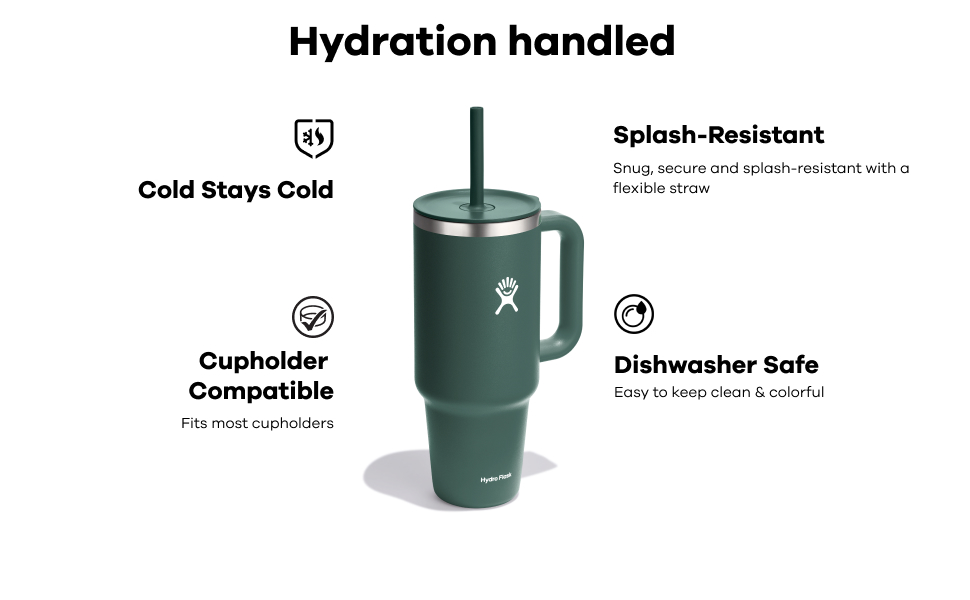


The Good, the Bad, and the Text-Heavy
The Good: The final content has a nice touch, mentioning that a portion of the proceeds is donated to build parks and contribute to the community. It’s always great to see a brand with a sense of social responsibility, especially since customers love feeling like they’re making a difference with their purchase.
The Bad: The A+ content is a bit of a snoozefest. It’s text-heavy and not very cohesive. The images don’t visually represent the features well, and there’s a disconnect between the text and images, leaving buyers confused.
Let’s Talk About Image 2
Image 2: This image highlights four core features of the thermos, but the design feels rushed. Three features have icons, but the “splash resistant” feature does not. Consistency is key! Plus, adding small explanatory images next to each feature would help customers instantly get what you’re talking about.
Final Thoughts
This set of images captures the “fun” aspect of the product with its dynamic and youthful vibe. However, it misses the mark on showcasing close-up shots of the features, leaving buyers unclear about the product’s composition. The visual elements need more relevance and detail to truly shine.
So, don’t let your product get lost in the Amazon jungle. Let’s make it the star of the show with stunning, intuitive, and unique A+ content!
If you are an Amazon Seller looking for free help with any Amazon related issues from me or other sellers with whom you can network, don’t hesitate and join our discussion forum for Amazon Sellers.
To stay in touch on Facebook, feel free to join and post into my large Amazon Seller Performance – Friendly Advice – Worldwide Facebook group, where you will be very welcome too.
Additionally, here you can watch my YouTube video, where I am presenting you several secret tips about appealing Amazon Seller Account suspensions (don’t be confused by the opening of the video, where I am enjoying a vacation – it’s a part of the story):
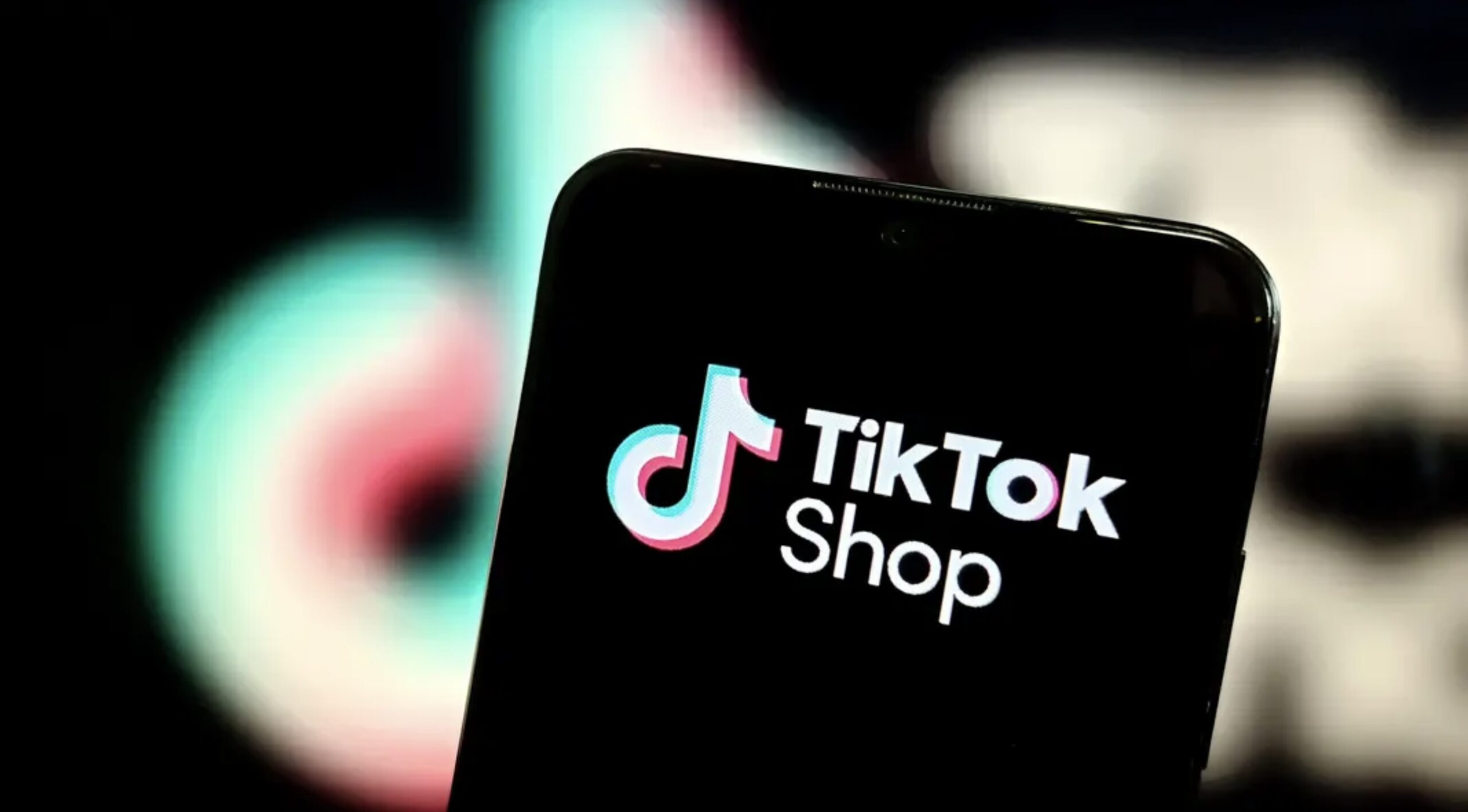
TikTok isn’t just for dance challenges and viral pranks anymore; it’s the new frontier for businesses looking to make a splash. With millions of users logging in daily for their fix of catchy and fun videos, TikTok has transformed into a selling powerhouse. If you’re not already leveraging TikTok Shops, you’re missing out on a goldmine of opportunity.
The Allure of TikTok Shops
TikTok’s charm lies in its simplicity and massive user base. It’s like the cool kid at school who everyone wants to be friends with. For businesses, this means a ready-made audience eager to discover new products. Plus, setting up shop on TikTok is straightforward and low-risk, making it a perfect playground for budding entrepreneurs.
Enter Inboostr: Your Secret Weapon
Here’s where things get exciting. Inboostr has created a database of over 100K influencers, complete with bespoke hygiene screening tools and thorough manual investigations into each influencer and their feed. Translation? We’ve done the legwork to ensure you’re partnering with top-notch influencers who can genuinely boost your brand.
Easy Peasy Logistics
Got products manufactured in China? No problem. Inboostr handles the logistics, shipping your goods to our American warehouse and managing your TikTok business. We connect your products to our big TikTok shop, giving you an easy entry into this booming market.
One-Stop Solution
Inboostr’s got you covered from start to finish. We help you find the right influencers, manage logistics, and run your TikTok business. All you need to do is watch the sales roll in.
Ready to Dive In?
TikTok Shops are more than just a trend—they’re a lucrative opportunity waiting to be tapped. With Inboostr’s comprehensive support, you can jump in with confidence and start reaping the rewards. So, what are you waiting for? The TikTok crowd is ready and waiting.
If you are an Amazon Seller looking for free help with any Amazon related issues from me or other sellers with whom you can network, don’t hesitate and join our discussion forum for Amazon Sellers.
To stay in touch on Facebook, feel free to join and post into my large Amazon Seller Performance – Friendly Advice – Worldwide Facebook group, where you will be very welcome too.
Additionally, here you can watch my YouTube video, where I am presenting you several secret tips about appealing Amazon Seller Account suspensions (don’t be confused by the opening of the video, where I am enjoying a vacation – it’s a part of the story):
-

 All Blogs & Seller News2 years ago
All Blogs & Seller News2 years agoYou would never think this could get you suspended! Amazon continues its wave of Buyer Account closures, learn what is new!
-

 Amazon Seller News3 years ago
Amazon Seller News3 years agoMeltable inventory restrictions start April 15, 2021
-

 All Blogs & Seller News2 years ago
All Blogs & Seller News2 years agoWatch out! Amazon is mercilessly cracking down on dropshipping!
-

 All Blogs & Seller News2 years ago
All Blogs & Seller News2 years agoHow to submit WEEE registration numbers on Amazon and what does it mean?
-

 All Blogs & Seller News2 years ago
All Blogs & Seller News2 years agoWhy isn’t Amazon doing anything to help third party sellers affected by the situation in Ukraine?
-

 Amazon Seller News2 years ago
Amazon Seller News2 years agoWhat is the difference between FNSKU and SKU?
-

 Amazon Seller News3 years ago
Amazon Seller News3 years agoFind out if any of your Amazon listings include prohibited keywords
-
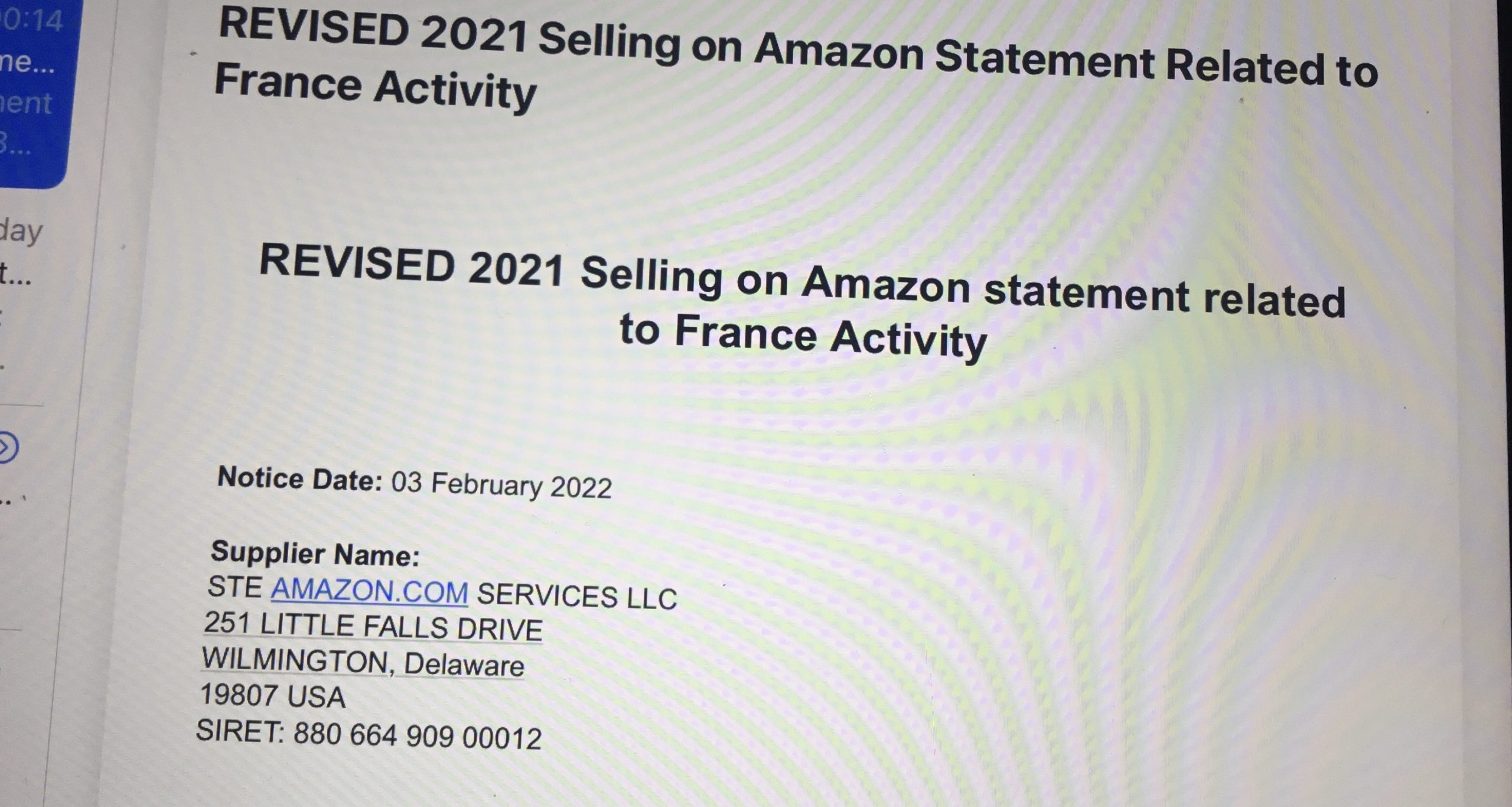
 All Blogs & Seller News2 years ago
All Blogs & Seller News2 years agoREVISED 2021 Selling on Amazon Statement Related to France Activity














Pingback: Amazon is now displaying messages regarding buyers who left the platform – Seller Union
Pingback: Watch out! Amazon now allows you to appeal suspensions without a Plan of Action if you do this! – Seller Union
Pingback: Watch out! Amazon is mercilessly cracking down on dropshipping! – Seller Union
Pingback: You would never think this could get you suspended! Amazon continues its wave of Buyer Account closures, learn what is new! – Seller Union
Pingback: Another blow from Amazon against dropshippers – Seller Union